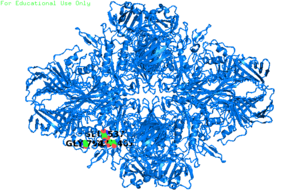β-Galactosidase
| β-Galactosidase | |||||||||
|---|---|---|---|---|---|---|---|---|---|
ExPASy NiceZyme view | | ||||||||
| KEGG | KEGG entry | ||||||||
| MetaCyc | metabolic pathway | ||||||||
| PRIAM | profile | ||||||||
| PDB structures | RCSB PDB PDBe PDBsum | ||||||||
| Gene Ontology | AmiGO / QuickGO | ||||||||
| |||||||||
Chr. 3 p22.3 | |||||||
|---|---|---|---|---|---|---|---|
| |||||||
β-Galactosidase (EC 3.2.1.23, lactase, beta-gal or β-gal; systematic name β-D-galactoside galactohydrolase) is a
β-Galactosides include carbohydrates containing
Function
β-Galactosidase is an
β-Galactosidase has many
β-Galactosidase is important for organisms as it is a key provider in the production of energy and a source of carbons through the break down of lactose to galactose and glucose. It is also important for the lactose intolerant community as it is responsible for making lactose-free milk and other dairy products. Many adult humans lack the lactase enzyme, which has the same function as β-galactosidase, so they are not able to properly digest dairy products. β-Galactose is used in such dairy products as yogurt, sour cream, and some cheeses which are treated with the enzyme to break down any lactose before human consumption. In recent years, β-galactosidase has been researched as a potential treatment for lactose intolerance through gene replacement therapy where it could be placed into the human DNA so individuals can break down lactose on their own.[5][6]
Structure
The 1,023
The third domain contains the active site.[9] The active site is made up of elements from two subunits of the tetramer, and disassociation of the tetramer into dimers removes critical elements of the active site. The amino-terminal sequence of β-galactosidase, the α-peptide involved in α-complementation, participates in a subunit interface. Its residues 22–31 help to stabilize a four-helix bundle which forms the major part of that interface, and residue 13 and 15 also contributing to the activating interface.[citation needed] These structural features provide a rationale for the phenomenon of α-complementation, where the deletion of the amino-terminal segment results in the formation of an inactive dimer.
Reaction
The enzymatic reaction consists of two chemical steps, galactosylation and degalactosylation. Galactosylation is the first chemical step in the reaction where Glu461 donates a proton to a glycosidic oxygen, resulting in galactose covalently bonding with Glu537. In the second step, degalactosylation, the covalent bond is broken when Glu461 accepts a proton, replacing the galactose with water. Two
In
Applications
The β-galactosidase assay is used frequently in
It is commonly used in molecular biology as a
A recent study conducted in 2020–2021 determined that Beta-Galactosidase activity correlates with senescence of the cells. Senescence of the cells can be interpreted as cells that do not divide, but cells that do not die. Beta-Galactosidase activity can be overexpressed, and this can lead to various diseases afflicting a wide range of body systems. These systems include the cardiovascular system, skeletal system, and many more. Detecting senescence cells can be achieved by measuring the lysosomal Beta-Galactosidase activity.[19]
A new isoform for beta-galactosidase with optimum activity at pH 6.0 (Senescence Associated beta-gal or
Evolution
Some species of bacteria, including E. coli, have additional β-galactosidase genes. A second gene, called evolved β-galactosidase (ebgA) gene was discovered when strains with the lacZ gene deleted (but still containing the gene for galactoside permease, lacY), were plated on medium containing lactose (or other 3-galactosides) as sole carbon source. After a time, certain colonies began to grow. However, the EbgA protein is an ineffective lactase and does not allow growth on lactose. Two classes of single point mutations dramatically improve the activity of ebg enzyme toward lactose.[24][25] and, as a result, the mutant enzyme is able to replace the lacZ β-galactosidase.[26] EbgA and LacZ are 50% identical on the DNA level and 33% identical on the amino acid level.[27] The active ebg enzyme is an aggregate of ebgA -gene and ebgC-gene products in a 1:1 ratio with the active form of ebg enzymes being an α4 β4 hetero-octamer.[28]
Species distribution
Much of the work done on β-galactosidase is derived from E. coli. However the enzyme can be found in many plants (especially fruits), mammals, yeast, bacteria, and fungi.[29] β-galactosidase genes can differ in the length of their coding sequence and the length of proteins formed by amino acids.[30] This separates the β-galactosidases into four families: GHF-1, GHF-2, GHF-35, and GHF- 42.[31] E. Coli belongs to GHF-2, all plants belong to GHF-35, and Thermus thermophilus belongs to GHF-42.[31][30] Various fruits can express multiple β-galactosidase genes. There are at least seven β-galactosidase genes expressed in tomato fruit development, that have amino acid similarity between 33% and 79%.[32] A study targeted at identifying fruit softening of peaches found 17 different gene expressions of β-galactosidases.[30] The only other known crystal structure of β-galactosidase is from Thermus thermophilus. [31]
References
- ^ Dorland's Illustrated Medical Dictionary. Archived from the original on 2006-10-16. Retrieved 2006-10-22.
- ISBN 978-1133106296.
- ^ a b "Glycoside hydrolase, family 1, β-glucosidase (IPR017736) < InterPro < EMBL-EBI". www.ebi.ac.uk. Retrieved 2015-12-11.
- ^ PMID 14621996.
- PMID 20377368.
- S2CID 33928719.
- PMID 6313347.
- ^ S2CID 4241867.
- PMID 15950161.
- PMID 23011886.
- PMID 1350782.
- PMID 7909660.
- S2CID 35101194.
- ISBN 978-0-470-47131-9.
- ^ PMID 16004951.
- ^ β-Galactosidase Assay (A better Miller) - OpenWetWare
- PMID 10698926.
- S2CID 9183717.
- S2CID 231957317.
- PMID 7568133.
- PMID 17920029.
- PMID 17634571.
- S2CID 82432911.
- PMID 318653.
- PMID 6793063.
- PMID 794482.
- PMID 3939707.
- PMID 1540130.
- ISSN 0022-0302.
- ^ .
- ^ PMID 15491613.
- PMID 10889266.
External links
- beta-Galactosidase at the U.S. National Library of Medicine Medical Subject Headings (MeSH)


